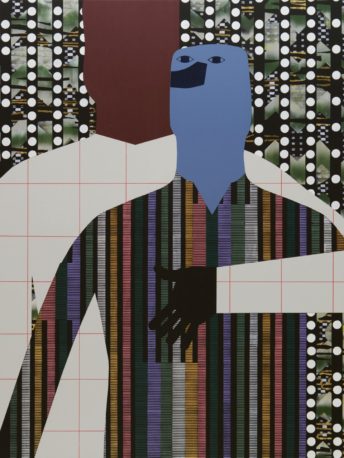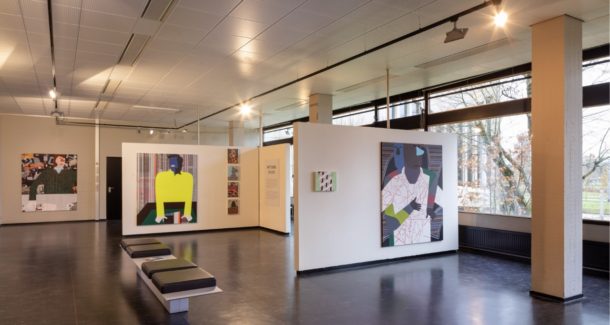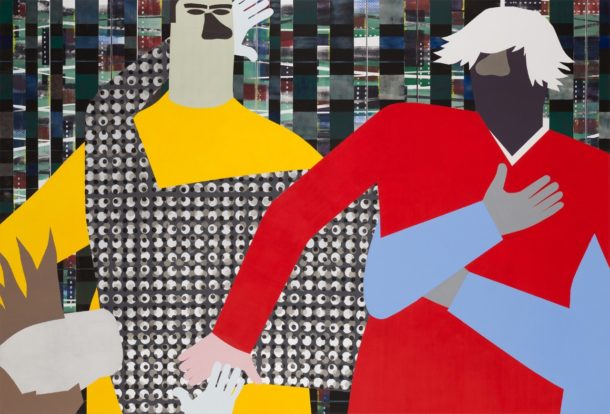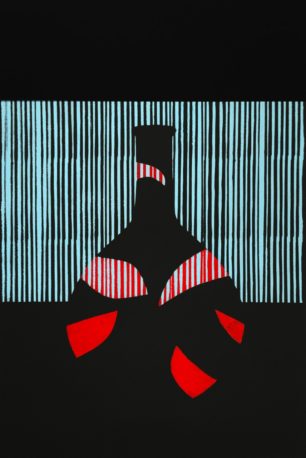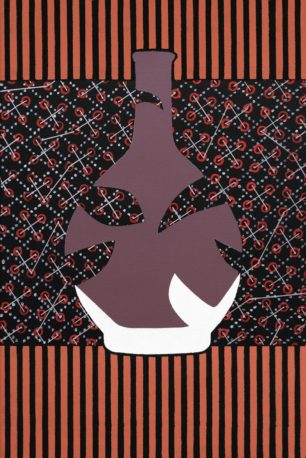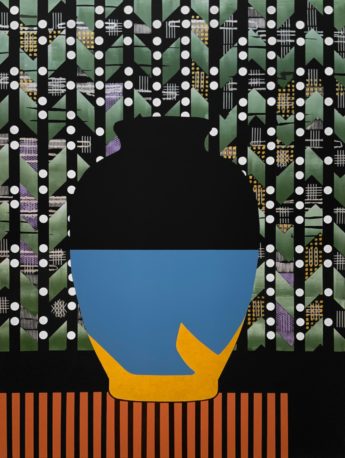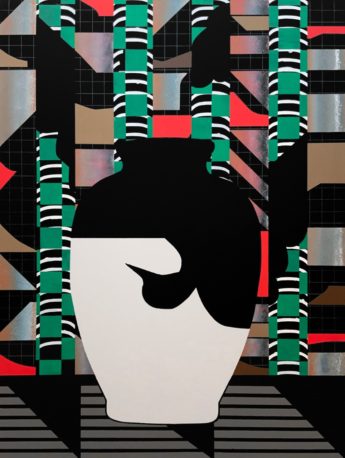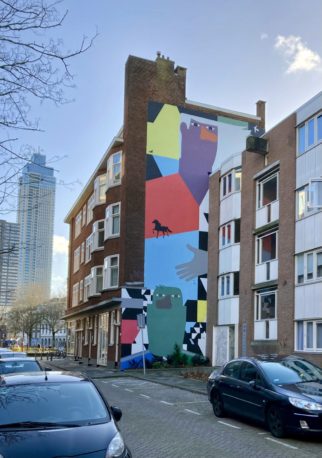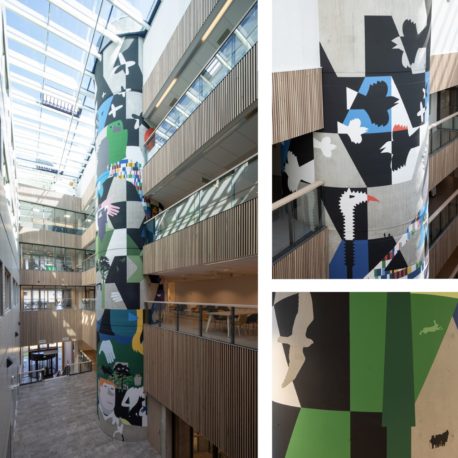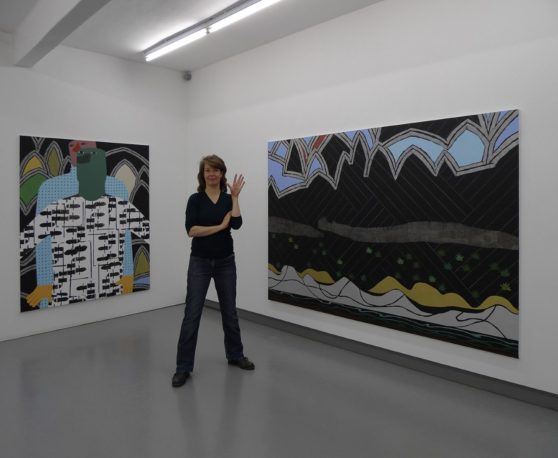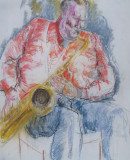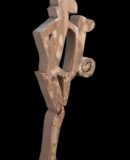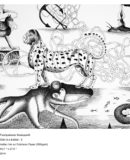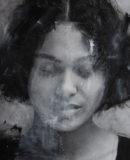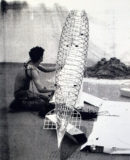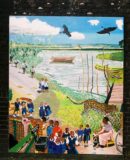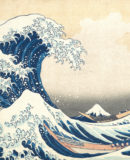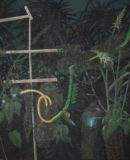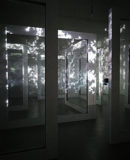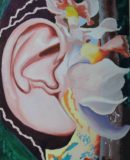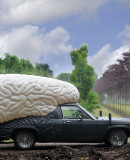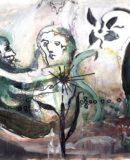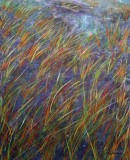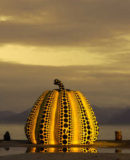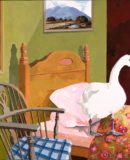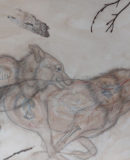World Fine Art Professionals and their Key-Pieces, 408 - Anuli Croon
World Fine Art Professionals and their Key-Pieces, 408 – Anuli Croon
Anuli Croon’s studio is located in a large building behind Rotterdam Central Station. Eight artists are housed in the building, there is a theater and several young people live in an assisted living project.
The studio is spacious and has a large rectangular wooden table in the middle with three lower layers. Above it hangs an extendable and rotatable lamp. Large-format works hang on the walls, including some ‘Embraces’ that I had seen Brutus at the ‘Wild Summer of Art’. In addition, there are some small format works (60 x 40 cm).
Own visual language
Anuli Croon has her own visual language. It is colorful, rudimentary, perspective-less and full of contrasts. She made those embraces because she wanted to show camaraderie between people, she says. Before, when she depicted people, they were always individuals.
In essence, this visual language could already be seen at the Art Academy in Den Bosch, where she graduated in 1989. She then worked with a roller. With a roller, tape and templates, she assembled her works. But it took her some time to really get her style. Thanks to two consecutive stipends from the predecessor of the Mondriaan Fund, the Fonds BKVB (Fonds voor Beeldende Kunsten, Design en Bouwkunst) in 1990 and 1991, she was able to experiment for two years.
Zooming in and out
She tried everything from a certain core. “Each time the outcome was ‘not quite’. Then I would have made another series of eight designs, and I would continue with the next set. Every time I crossed out variants, as it were, based on the restriction. At some point it all came together. It was precisely those limitations that I imposed on myself that turned out to contain leeway.”
Against a wallpaper-like background surface, the sight zooms in and out at the same time. “I want to use all the influences. That can be textiles, clothing, painting. It should not have a narrative connotation beforehand. Rather, it should challenge the viewer to create new connotations.”
Vases
Now she is busy with vases, vases of flowers. “In the 17th century you had them, floral still lifes. I started with small size. I’ve been trying that for a while. I’m talking about the vase itself. On top of that I place a floral motif. I often cut it as a sketch. That vase is always in an interior with, for example, wallpaper or slats.” There are now two series, simple, Japanese-like vases and more baroque ones. At a certain moment the large vases appeared. Those became pot vases. A trio hangs behind me.
“I want to show something very clear. I do that by simplifying and zooming in so that you can always see different things in it.” Her noses are famous. In 2001, she still had a fainter, smaller nose. A petit nose. Now it’s a Walter Matthau nose. It is a consequence of how her work developed.
“I reduced all the elements to a basic shape. The nose was the last element I applied that to. Realizing that that could be perceived as clownish or annoying. Then again in almost the same tone as the face, then again set up in a rich contrast. A big nose was a thing of prestige in ancient times, intelligence. It fascinates me that meanings differ over time, per culture, per individual.”
Furniture, lamentations, city fragments
For example, she made a large-format series of furniture, with anonymous pieces of furniture, a series of lamentations, reduced to the core: ‘falling’ and ‘helping’, based on the work of Rogier van der Weyden. A series of city fragments. It started big, but it got small. Many series come back over time.
When she finds herself repeating herself, she stops. And she explores another topic. Both the different subjects and the assignments influence each other. It is becoming increasingly clear what belongs where.
Does Anuli have a key work?
Not right away. “Each series has its own urgency.” Looking back, she finds it important that something was successful. “For example, Interior IX from 2007. That was very exciting to do. It was an architectural construction, as all my works can be called constructions, pushing and fitting and measuring. I do have a plan, but I will eventually figure it out on the canvas.”
Assignments
Since 2007 she also carries out assignments in public space. These can be wall, window or wall paintings. The first major assignment was in the post-war district of Pendrecht. Architect and urban planner Lotte Stam Beese, who joined the Bauhaus in the 1930s, designed a new residential area with the key words light, air and space. Fitting in with Van Schagen Architecten’s renovation plan, she made window designs for the stairwells of six low-rise flats. She shows the design, architectural elements, landscape, greenery and stylized plants. The six images echo each other just like the stamps of Stam-Beese.
She even worked in the glass factory for two months to make the glass – a combination of float, colored glass, milk glass and überfang on architectural glass.
Central Military Hospital
From then on she got more assignments, sometimes she applied, or she was shortlisted, most of the time she was asked. We look at the concrete pillar/column she completely transformed for the Central Military Hospital in Utrecht. That pillar is located in the central hall, was made of gray concrete, four stories high. To empathize, she was given a number of guided tours of military buildings and sites throughout the Netherlands. The art committee consisted of members of the five branches of defense (land, air force, navy, military police and cybercrime) and an external art advisor.
It is a complex puzzle that she had to solve, nursing, staff and soldiers viewed the pillar differently from each floor. She divided it into land, water and air, using the colors of the soldiers’ clothing. There was a call for an emphasis on camaraderie and nature. For example, at the very bottom you see a real soldier in sports uniform with a supportive hand of another on his shoulder. And in between are batons, small pieces of ribbon in many colors on the uniform that represent the awards.
The inside of the pillar had a different scale and was given another display. There, silhouettes of animals have been included in the design that represent the character traits of the soldier as mythical animals. A godwit, porpoise, fox, owl, harrier, hare, otter, pike, bat and a water beetle. In addition, the equipment of parts of the Ministry of Defense such as the Walrus submarine, the Chinook helicopter and an armored vehicle.
Zwarte Paardenstraat (Black Horse Street)
In the Zwarte Paardenstraat, near the Witte de Withstraat in Rotterdam, you can also see a large mural of her hand. She was asked by CBK Rotterdam to respond to another painting in the street, a multicolored horse by the Chilean artist Jorge Kata Nunez. Nunez’s horse has been given a place in her design in the form of two black silhouettes of a horse. It has become a beautiful work in various colors with a purple face with a red nose that looks out over the roofs at the top and a dark green figure with a black nose at the bottom.
What is her experience of art life?
“I love the work very much, especially the research is super fun. I make sure it doesn’t become a routine. I can work well together on assignments. I find the world around it quite complicated at times.”
Finally, what is her philosophy?
“I make works on everything around me. The work poses questions rather than being a finished thing. I work inquisitively, from doubt, with an open attitude. That way I let things come to me and I start developing it.”
Images
1) embrace, 2) photo by Scagliola, 3) embrace, 160x120cm, 4) vase, 60×40, 5) vase, 60×40, 6) vase, 160×120, 7) vase, 160×120, 8) mural Zwarte Paardenstraat, 9) Central Military Hospital, photo by Scagliola, 10) portrait photo Anuli Croon
https://anulicroon.nl/https://www.instagram.com/anuli_croon/https://www.facebook.com/people/Anuli-Croon/1025795904/https://kunstambassade.nl/kunstenaars/anuli+croon/https://ifthenisnow.eu/nl/verhalen/de-wereld-van-de-rotterdamse-kunstenaar-60-anuli-croon
Disclaimer: The views, opinions and positions expressed within this guest article are those of the author Walter van Teeffelen alone and do not represent those of the Marbella Marbella website. The accuracy, completeness and validity of any statements made within this article are not guaranteed. We accept no liability for any errors, omissions or representations. The copyright of this content belongs to Walter van Teeffelen and any liability with regards to infringement of intellectual property rights remains with the author.

